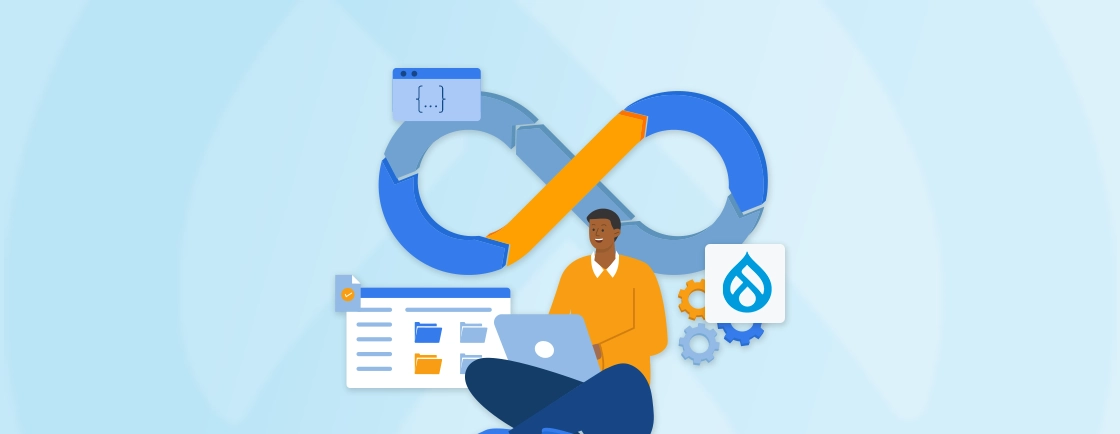Table of Contents
According to W3Techs, WordPress is the most widely used content management system in the world. More than 43 % of all websites are developed using WordPress on the internet. WordPress, on the other hand, is a monolithic platform with a closely integrated frontend and backend that makes it unmanageable for developers who want to create digital experiences that are not dependent on the theme-based structure of WordPress.
It’s possible that detaching the front end from the backend will solve your problems if you’ve ever felt locked or stuck when working with WordPress. Going for headless will give you a wealth of new opportunities, including new frameworks, technological stacks, and delivery channels. This allows for flexible front-end choices, such as headless WordPress React.
Here, we are going to talk about how to build a headless WordPress website with Angular. Because big enterprises like Upwork, Freelancer, PayPal, Deutsche Bank, Forbes, and Guardian use Angular as their front-end.
What is Headless WordPress?
A headless WordPress website is a site that mainly uses WordPress for content management and uses any other technology to build the front end and display the content to the website visitors.
The headless CMS differs from a traditional CMS in terms of architecture. The headless CMS architecture separates the front end and back end of the site, splitting it into two virtually autonomous systems. In contrast to the one system that produces, stores, and manages information, the other system exposes data to end-users through graphical user interfaces (UIs) such as a website, smartphone application, or Internet of Things device. When developing a headless When developing a headless WordPress website, developers use a REST API to communicate between the backend and the front end.
Rest API allows developers to interact with cross-technology interfaces as long as both speak the same language of JSON. WordPress Rest API spits out data in JSON format, which is understandable by a large number of web technologies. JSON is a text-based representation of JavaScript objects which contains data in key-value pairs.
"names": [
{
"id": 0,
"name": "John Doe"
},
{
"id": 1,
"name": "Richard Lindley"
},
{
"id": 2,
"name": "Jack Moore"
}
],
Today, we will demonstrate the power of WordPress Rest API by using it with Angular and WordPress as headless CMS for my basic web application.
The Benefits of Using Headless WordPress CMS
Being an open-source platform, WordPress offers great flexibility to create any website. Using WordPress as a headless CMS allows you to create the front-end of your web application using any web technology and manage its content a popular CMS.
You might come across a situation where you need to add a blog feature to an existing web app built with either Vue.js or React. Instead of coding the full-fledged content management system in the native framework, use headless WordPress CMS to manage the content using Rest API.
The following are some of the advantages of headless WordPress as compared to traditional WordPress, that makes it more effective to use:
- Flexibility: A Headless CMS allows for greater flexibility in terms of programming language and framework selection, removing many of the constraints associated with the traditional paradigm. Additionally, similar data can be reused across multiple projects with a simple export, which is advantageous in the event of a CMS change.
- Security: It is less vulnerable and prone to third-party application problems because your material is stored apart from your front-end delivery system.
- Multichannel: A Headless CMS enables you to manage your content across various channels, providing significantly increased adaptability and a seamless user experience. The material is regarded as “pure” because the REST API transmits the data in JSON format, which could be reused and read by any front end.
- Optimized site loading time: Because the presentation layers are separated and the logic for presenting data is relocated to the client side, the speed of data transmission is significantly increased. This performance gain is a major reason developers adopt a system like WordPress as a headless cms for NextJS.
- Deeper visual control: Even the most complex WordPress themes or web page templates can’t be changed. If you’re a front-end developer or a content creator, the headless architecture gives you a lot of freedom when it comes to how your content looks on the web.
How to Set Up a WordPress Site with Angular
Let’s begin with setting up the WordPress site, as this will act as a data source for our front-end Angular application.

Rest API will be enabled by default. If you want to restrict the Rest API access then you can use Basic-Auth or Oauth2 authentication method.
Go to Settings → Permalinks and select either Post name or Custom Structure.

Since we are working with API calls, download the chrome extension for Postman. Inside the Postman, enter the URL in the following format:
https://example.com/wp-json/wp/v2/posts
The above URL will fetch the post data inside your WordPress site.

Getting Started with Angular

What is Angular?
Angular is considered a web application development tool that’s always been chosen by web developers and programmers because of its progressive features. Compared to other JavaScript frameworks, Angular offers unique functionalities and advantages. As a result, Angular has become one of the most popular frameworks in the world. With its agile development process, the project is able to save a lot of money as well as time on the development side of the project. The bottom line is, as a business owner, if you are thinking about developing a web app but are confused about how to choose the right framework to use, then AngularJS will be the ideal choice to make.
Setting Up Angular App
In this article, we will be building a blog page that will list the post title and content. All the backend content management of the project will be developed with headless WordPress.
To build Angular apps, you need to have the following dependencies installed on your computer.
- NodeJS
- Node Package Manager (NPM)
- Angular CLI
- Text Editor such as Sublime or Visual Studio Code.
- Git for version controlling (Optional)
To check whether you have installed Node.js and NPM, Use the following command line to check the version, also check whether you installed Node.js and NPM properly or not.
node -v
npm -v
Install Angular through CLI
Once you completed the installation of (Node Package Manager) NPM, you can install Angular CLI in the following steps. Open your terminal or command prompt in your system and enter the below command.
npm install -g @angular/cli
The above command installs the Angular globally in your system, g stands for global installation.
Check the Angular CLI version
Once the installation is completed, use the following command to check whether the Angular application installation is completed successfully or not. Also, check the current Angular version CLI.
ng v
Create a New Angular App with the CLI
After setting up the environment, open the command line and run the following code to create the project
ng new blog
Where the blog is the project name. Once the project is created, run the following command and you will be able to see the angular app project output on http://localhost:4200
ng serve
Lastly, open your angular codebase with any code editor of your choice. We will go with VSCode, and let’s get our hands dirty with codes.
Now open the app.module.ts and import the HttpClientModule like below I was given.
import { BrowserModule } from '@angular/platform-browser';
import { NgModule } from '@angular/core';
import { HttpClientModule } from '@angular/common/http';
import { AppRoutingModule } from './app-routing.module';
import { AppComponent } from './app.component';
@NgModule({
declarations: [
AppComponent
],
imports: [
BrowserModule,
AppRoutingModule,
HttpClientModule
],
providers: [],
bootstrap: [AppComponent]
})
export class AppModule { }
Now open the app.component.ts and import the HttpClient, Once you added that next declare the post variable and get the post data through the WordPress post URL. Below I provided how to get the data through the WordPress Rest API URL.
import { Component, OnInit } from '@angular/core';
import { HttpClient } from '@angular/common/http';
@Component({
selector: 'app-root',
templateUrl: './app.component.html',
styleUrls: ['./app.component.css']
})
export class AppComponent implements OnInit {
posts = [];
constructor(private http: HttpClient){}
ngOnInit(): void{
this.http.get('https://example.com/wp-json/wp/v2/posts').subscribe(data =>{
for(let key in data){
if(data.hasOwnProperty(key)){
this.posts.push(data[key]);
}
}
console.log(this.posts);
})
}
}
The final step is to display the post in the loop with ul > li tags like the below I have given. In the code, you see we used ngFor to loop the Rest API post data in the app.component.html.
<ul>
<li *ngFor="let post of posts">
<h1>{{post.title.rendered}}</h1>
<p [innerHTML]='post.content.rendered'></p>
</li>
</ul>
Summary
Headless WordPress and the benefits it comes with are here to stay for a while. Its popularity will only continue to grow as more developers and site owners come to understand the benefits of a headless option. Implementing a robust and scalable headless setup, however, often requires specialized architectural expertise, making it a perfect project for a custom WordPress development company. You’ve now learned how headless WordPress works and why it’s so often used.
Now you know what headless WordPress is and how to integrate it with Angular. You can also take it a step further and integrate your WordPress site with React to deliver a fast, dynamic, and modern user experience. If you need expert assistance in building a headless website with these technologies, Hire Dedicated WordPress Developers from us, who can ensure everything is implemented seamlessly for optimal performance.
FAQ Related to Headless WordPress Site with Angular
What is Headless WordPress?
Headless WordPress is a CMS setup where WordPress is used for managing content while a different technology is used for the front-end display to visitors1.
Why use Headless WordPress?
Benefits include greater flexibility in programming, enhanced security, multi-channel content management, improved site loading time, and deeper visual control1.
How to set up WordPress for Angular?
Enable Rest API in WordPress, adjust permalink settings, and use tools like Postman to test API endpoints1.
How to get started with Angular for a Headless WordPress site?
Install necessary dependencies like NodeJS, NPM, and Angular CLI. Create a new Angular app using CLI and develop your front-end while interacting with WordPress through REST API1.
Master AngularJS with Expert Insights
Unlock the full potential of AngularJS through in-depth tutorials, best practices, and real-world applications.





